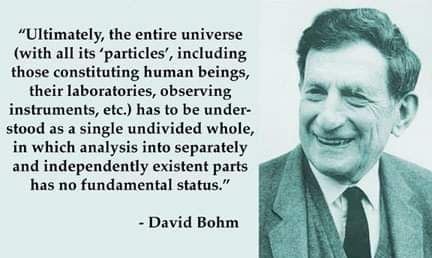
David Bohm, one of the most distinguished theoretical physicists of his generation, will be remembered above all for two radical scientific theories: the causal interpretation of quantum physics, and the theory of the implicate order and undivided wholeness.
He suggests that the quantum potential is itself organized by a super-quantum potential, representing a second implicate order, or super implicate order. Indeed he proposes that there may be an infinite series, and perhaps hierarchies, of implicate (or 'generative') orders, some of which form relatively closed hoops and some of which do not. Higher implicate orders organize the lower ones, which in turn influence the higher.
He believes that life and consciousness are enfolded deep in the generative order and are therefore present in varying degrees of unfoldment in all matter, including supposedly 'inanimate' matter such as electrons or plasmas. He suggests that there is a 'protointelligence' in matter, so that new evolutionary developments do not emerge in random fashion but creatively as relatively integrated wholes from implicate levels of reality. The mystical connotations of Bohm's ideas are underlined by his remark that the implicate domain -could equally be called Idealism, Spirit, Consciousness, separation of the two - matter and spirit - is an abstraction. The ground is always one.
As with all truly great thinkers, David Bohm's philosophical ideas found expression in his character and way of life. His students and colleagues describe him as totally unselfish and non-competitive, always ready to share his latest thoughts with others, always open to fresh ideas, and single-mindedly devoted to a calm but passionate search into the nature of reality. In the words of his students, -He can be characterized as a secular saint.
Bohm believed that the general tendency for individuals, nations, races, social groups, etc., to see one another as fundamentally different and separate was a major source of conflict in the world.
It was his hope that one day people would come to recognize the essential interrelatedness of all things and would join together to build a more holistic and harmonious world. What better tribute to David Bohm's life and work than to take this message to heart and make the ideal of universal brotherhood the keynote of our lives.
From: David Bohm and the Implicate Order, by David Pratt
Reprinted in the Theosophical Digest, 1st quarter, 1999
Among the visionaries who wandered the threshold between matter and mind, between physics and philosophy, David Bohm stands like a quiet beacon. A student of quantum theory and a friend to mystics, Bohm saw what others could not—or would not. While many physicists treated the strange behaviors of the quantum realm as mathematical quirks to be endured, Bohm listened deeper. He asked: What if these were clues? What if reality is not fragmented, but fundamentally whole—and our perception of separateness is the illusion?
Bohm’s greatest offering to physics and to the future of thought was not a formula, but a new worldview—an ontological re-enchantment of the cosmos. He challenged the prevailing interpretation of quantum mechanics, which had accepted uncertainty and randomness as ultimate. To Bohm, randomness was the surface ripple of a deeper, unseen current.
At the heart of his vision lies the concept of the Implicate Order. In this framework, the world we observe—what Bohm called the Explicate Order—is like a holographic projection from a deeper reality, one that is enfolded, subtle, and unified. Just as a hologram encodes the whole image in every part, so too does the implicate order hold the entirety of the universe within each particle, each moment. There is no true separation, only unfolding patterns of coherence that appear as distinct forms in space and time.
Bohm’s physics became philosophy, and his philosophy touched the edge of mysticism. He spoke of undivided wholeness in flowing movement, a cosmos alive with hidden intelligence. In dialogue with Krishnamurti, he explored how thought fragments the world, dividing subject from object, observer from observed. But beneath these mental divisions lies a field that is whole, dynamic, and alive. In this light, consciousness is not confined to brains—it is woven into the fabric of reality itself.
His interpretation of quantum theory returned depth and elegance to a field that had been flattened by probability and pragmatism. In Bohm’s model, the “quantum potential” guides particles in a nonlocal, holistic manner. Information flows beneath the surface, connecting distant events in ways that transcend light-speed limitations. This was the physics of relationship, of resonance, of form arising from formlessness.
Though often sidelined by mainstream academia, Bohm’s ideas have seeded revolutions in neuroscience, consciousness studies, and cosmology. His vision of a holographic universe influenced thinkers like Karl Pribram and even inspired philosophical explorations in art, education, and social theory.
To study Bohm is to awaken to a startling realization:
The world is not a machine—it is a movement.
Meaning is not made—it is revealed.
You are not separate from the whole—you are the whole, enfolded uniquely.
David Bohm did not seek to control the universe.
He sought to listen to it,
to commune with it,
to remember what it had always been whispering:
All is one.
The part contains the whole.
And the whole is becoming itself—through you. [anon]
See Also
